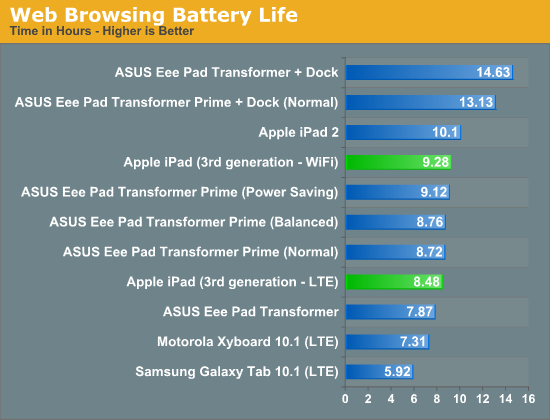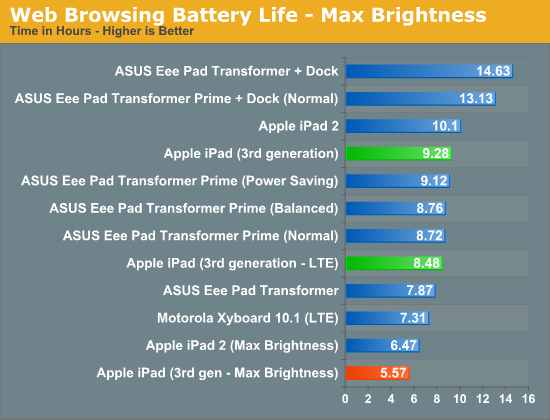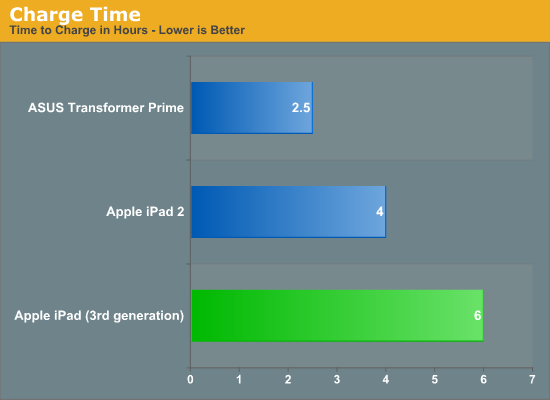The Apple iPad Review (2012)
by Vivek Gowri & Anand Lal Shimpi on March 28, 2012 3:14 PM ESTBattery Life
For a company that has been so laser focused on reducing weight and device thickness, the new iPad actually growing in both of these dimensions was unexpected. From a technical standpoint, the tradeoff makes sense. The new Retina Display consumes significantly more power than its predecessor, as do the A5X and MDM9600 baseband. Both of those ASICs are still built on a 4x-nm LP process and will surely increase power consumption over the iPad 2.
With more transistors switching on the same process node and a display (and backlight) driving more pixels at the same brightness, the battery either had to be larger or battery life would suffer. Apple understandably chose the former and the new iPad ships with a 42.5Wh battery—the largest we've ever seen used in an ARM tablet. The new iPad's battery is so large it's even bigger than what Apple uses in the 11-inch MacBook Air, and it's within striking distance of the 50Wh unit you'll find in the 13-inch model. I do believe this move says a lot about how Apple sees the iPad moving up in the world, but I'll get to a discussion about that later.
With a 70% larger battery than the iPad 2 but with more power hungry components inside, how does the new iPad fare in real world usage? Subjectively: it doesn't last as long as its predecessor. Objectively, our numbers seem to agree.
Our web browsing battery life test browses through dozens of web pages, pausing on each to simulate reading time, until the battery is depleted. All of our tests are run at the same brightness settings (200 nits) to ensure we are comparing apples to apples.

On WiFi we measured an 8% decrease in battery life compared to the iPad 2—nothing huge but not insignificant either. Fall off of WiFi and depend on LTE and you'll see around a 9% decrease in battery life, again—noticeable but not unusable.
I also threw in numbers from the Motorola Xyboard 10.1, an LTE enabled Android tablet running 3.2. Equipped with a much smaller battery (~26Wh), the Xyboard 10.1 delivered 7.31 hours in our LTE web browsing test. The new iPad managed to last 16% longer on a single charge—a smaller advantage than you'd expect given the 70% increase in battery capacity, showing just how much power the new Retina Display and its backlight consume.
The iPad is more than usable on long flights or throughout the day without being tethered to a wall outlet, but in practice you can expect a decrease in battery life compared to last year's model.
Keep in mind that these values are all at 200 nits (roughly 70% brightness on the iPad). If you use the iPad at max brightness (~400 nits) you'll see considerably lower numbers:

In our web browsing test, at max brightness, we saw 5 hours and 34 minutes of continuous use before the battery died. The iPad 2 incurs a similar penalty, lasting under 7 hours in the same test. Do keep this in mind if you need to get a lot of untethered use out of the new iPad. In order to come close to Apple's battery life estimates you'll have to be below 70% brightness.
Charging
Despite the significant increase in battery capacity, Apple continues to ship the new iPad with the same 10W USB power adapter as the previous two models. You can charge the iPad via a Mac/PC USB port that implements the USB charging spec, however doing so will take a minor eternity to fully charge the tablet. Just as before, the new iPad will not charge off of a USB port if the tablet is awake; it will only charge when locked/asleep. The convenience of having a USB based charger is evident, but you'll want to stick with the 10W adapter to actually charge the iPad.
Charging the larger battery does take longer. If we measure from a completely dead state to when the iPad indicates that it's fully charged the increase in time is approximately 50%, from 4 hours with the iPad 2 to 6 hours with the new iPad. ASUS' Transformer Prime, by comparison, requires only 2.5 hours as it ships with an 18W charger. And no, you can't use ASUS' charger to speed up charge times on the new iPad—when connected, the TF Prime charger will only supply 9W to the iPad.

The story doesn't end there however. While the iPad 2 will draw 0W after its 4 hour charge cycle is complete, the new iPad will continue to draw around 3W after it claims to be fully charged. This will continue for roughly another hour at which point the power adapter will draw anywhere from 0.1—0.6W.
Note that when running at full brightness and with a heavy GPU load (e.g. Infinity Blade 2), the power adapter can't supply enough to keep the iPad charged and drive the display/internal components.
There's no good solution here other than for Apple to start shipping the iPad with a higher wattage power adapter. I do believe faster charge times are going to be necessary if Apple is keen on sticking with this larger battery, not to mention the usage issues of not being able to maintain charge equilibrium under load.
Thermals
The increase in power consumption of the new iPad also manifests in the form of increased heat production. A 163mm^2 SoC built on a 45nm LP process is a serious chip. Although it doesn't run hot enough to require active cooling, the SoC alone is responsible for a couple of watts of the iPad's TDP under heavy load. Combine that with a 45nm LTE modem and the heat put off by the more powerful backlight and you've got a recipe for a noticeably warmer device.
Does the new iPad get warmer than the previous one? Absolutely. I would even go as far as to say that it can get uncomfortably warm, but it never gets too hot to hold. If you've used any of the modern Mac notebooks, I don't believe it's anywhere near as bad.
When holding the new iPad in portrait mode, with the home button at the bottom, the lower left corner of the device ends up being the warmest. Along the left edge of the iPad is where the logic board resides, and the lower half is home to the A5X SoC. Under load, particularly a heavy GPU load (e.g. playing a 3D game), this area is going to heat up quickly.
I took several measurements using a contactless IR thermometer in the same ambient conditions on a new iPad vs. the iPad 2. The results are below:
| Thermal Comparison (Max Temperature) | |||||
| iPad 2 | iPad (3rd generation) | ||||
| Web Browsing (2 hours) | 32.7˚C | 37.6˚C | |||
| Infinity Blade 2 (1 hour) | 34.2˚C | 41.9˚C | |||
Again, I don't believe this is a deal breaker but it's the obvious result of remaining on Samsung's 45nm LP process combined with a more power hungry display/backlight. I suspect there will be improvements in efficiency on the display side over time, but I can't see the Retina Display being any lower power than the iPad 2's 1024 x 768 screen. The real avenue for improvement will be when Apple shifts to 28/32nm silicon for the SoC and LTE modem. If you want a cooler running iPad, you'll have to wait until next year for that.










234 Comments
View All Comments
mr_ripley - Friday, March 30, 2012 - link
It's a shame some people argue that against the workers when over a hundred of them have committed suicide over the working conditions. How can you still say that they are being offers a better deal here??On the other hand, it is also unfair that Apple is being singled out here. The world of Chinese manufacturing is a dirty one and all major corporations have a part in it. I'd trust Apple over most other companies to make a difference in that regard, and I'm happy to see something is being done in that regard. Ever heard McDonalds CEO touring the slaughterhouse of the meat packing companies??
name99 - Friday, March 30, 2012 - link
Reporting suicides as a number not as a rate shows you to be either a fool or a deliberate liar. How many people, over how many years, comprise the pool from which this suicide number is drawn? Everything I have read says that the actual suicide rate is not only lower than the average rate for China, it is lower than the average rate for the US.mr_ripley - Friday, March 30, 2012 - link
In 2010, 18 workers attempted sucide, 14 succeeded. To me even one in a whole year is not acceptable. If you think that is ok I hope that statistic turns out to be you!!name99 - Saturday, March 31, 2012 - link
The argument was NOT that suicide is a tragedy, it was a claim that FoxConn employees specifically tied to Apple production have such lousy lives that they commit suicide in higher numbers that other people around the world.You have done NOTHING to prove this claim; all you have done is bring up a very different issue.
mr_ripley - Saturday, March 31, 2012 - link
There is no disputing the fact that these deths are related to working conditions. I'm pretty sure this has been well established and documented. However, I did say in my previous post that Apple is unfairly singled out. It could have been any other company.Comparison between suicide rates is irrelevant. Higher sucide rates elsewhere does not justify this problem. Again the fact remains that many people have died and it is directly related to the working conditions.
Apple happens to be in a position to directly influence their lives and make it better, after all they profit in billions from the work these people do. Corporations typically place little value over human life and living conditions (IBM sold equipment to the Nazis to track the Jews in concentration camps). Somehow, I feel Apple is different.
doobydoo - Sunday, April 1, 2012 - link
Dude, sorry but you're talking no sense at all.First of all, pretty much any product you want to buy, electronics wise, uses parts from China where conditions are far worse on average, than Apples factories. So if you actually factored working conditions into the product review, it would look favourable for Apple.
Secondly, your argument that comparison between suicide rates is irrelevant, is absurd. Higher suicide rates where legislation is such that no jobs suffer such terrible conditions that suicide is the only option, such as is the case here, prove that even if working conditions are refined, you still get some depressed people. Your argument, therefore, is with the people who committed suicide. You say it is 'directly related to the working conditions' but where have you evidenced this, at all? You simply haven't. The fact that the suicide rates at Apple factories are lower than some American ones further backs up my point on this.
Every company is in a position to change lives and make them better. You too, are in a position to do this. But guess what. You, just like companies, can do WHATEVER YOU LIKE with your OWN MONEY and have NO OBLIGATION WHATSOEVER to solve the worlds problems. Apple already has amongst the best conditions of factories in China. The amount of profit they make is absolutely irrelevant, if you say Apple should be putting money into this then a lot more manufacturers should also put a lot more money into this. It's very easy to decide what other people 'should' do with their money now, isn't it?
Corporations don't have to adhere to moral values - they are not people. They are there solely to make money. Nothing else. Don't confuse them with people. And I hope you donate every single spare penny to charity and spend every spare second of your time working to build homes in the 3rd world. Oh wait, you're on here crying that other people should do it instead.
Get a hold of yourself you illogical fool.
mr_ripley - Sunday, April 1, 2012 - link
Like I have said before it is a shame some people argue with great zeal against others who are suffering and devalue human life. Fortunately, Tim Cook is not one of them.If scores of people killing themselves citing poor working conditions is not enough proof what is? If your claim that there are work environments in America that have higher suicide rates because of working conditions is true that needs to be investigated as well and rectified.
You give charity to people who are in need and cannot earn for themselves. If you think giving someone fair amount of compensation for hard work is charity you are delusional.
If working in those factories is such a pleasent experience I suggest you try it out for yourself. Maybe the experience might broaden your perspective.
Although, I don't see the point I will attempt to educate you. Legally, a corporation is considered as a person, that is right just like a live human being. Regardless of that corporations are run by people and actions of a corporation reflect upon the morality of the people running them.
I will stop here as there is no point in continuing but you can respond with more insults and accusations of what I do or have done which frankly is no concern of yours.
PeteH - Monday, April 2, 2012 - link
I've not seen a single report of people killing themselves and citing "poor working conditions" as the reason. Can you provide a link?There have been reports of people killed because of unsafe working conditions, but that's a different issue. Maybe you're confusing the two.
mr_ripley - Tuesday, April 3, 2012 - link
Here's a Wikipedia link: you can read some of the circumstances and judge for yourself.They may not have said it in so many words but it is clear they were unhappy with ther work environment.
Imagine your boss coming and beating you up because you lost an iPhone prototype!!!
mr_ripley - Tuesday, April 3, 2012 - link
http://en.wikipedia.org/wiki/Foxconn_suicides